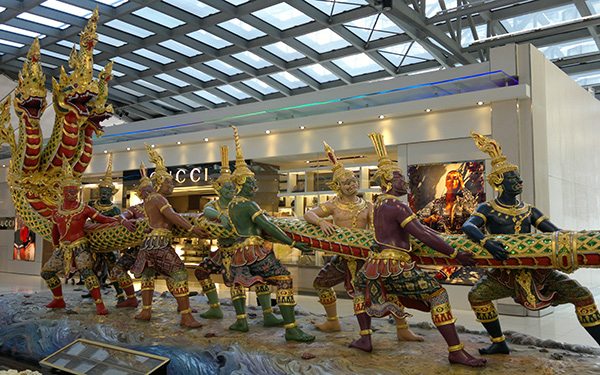The next tranche of construction projects scheduled for Suvarnabhumi will see the airport’s capacity increased to 60 million passengers a year, from just 45 million as of now.
2016 is set to see the Phase 2 development of the international aviation hub, with three construction projects worth a combined ฿18 billion (US$500 million) slated to begin in June, reports the Bangkok Post.
The projects include utility installations for electricity, water and air-conditioning systems, the construction of an apron, taxiways to lead to the new apron and underground work.
The proposed 960,000 square metre apron will be able to accommodate 28 jetliners, including eight A-380 super jumbo jets.
Phase 2 is comprised of an additional four construction projects for the airport – including a midfield satellite concourse building and a new tunnel linking to the planned concourse – although they will not be put out for tender until later this year.
Completion of Phase 2 is slated for 2019, according to Prasong Poontaneat, chairman of the Airports of Thailand board.
Suvarnabhumi isn’t the only transportation hub facing expansion; plans are afoot for a multi-airport rail link service linking together Survanabhumi, Don Mueang and U-Tapao.
U-Tapao airport is owned by the navy and located in Rayong, but is opening up for commercial service later this year in a bid to relieve overcrowding at Bangkok’s airports.
While a rail link is already in place from Phaya Thai to Suvarnabhumi, construction is slated to begin in September this year for a ฿31.1 billion (US$860 million) line between Phaya Thai and Bang Sue, in tandem with the Light Red Line project linking Bang Sue with Hua Lamphong and Hua Mak.
Currently under consideration is an extension of the rail link line from Bang Sue to Don Mueang, while studies have also been ordered by the government on a potential rail link between Suvarnabhumi and U-Tapao too.
The latter is not considered a priority, according to Ormsin Chivapruck, deputy transport minister, but will be of import in the future. Costs are likely to end up somewhere north of ฿100 billion (US$2.8 billion).
Featured image is by Al Pavangkanan and used under a Creative Commons licence


